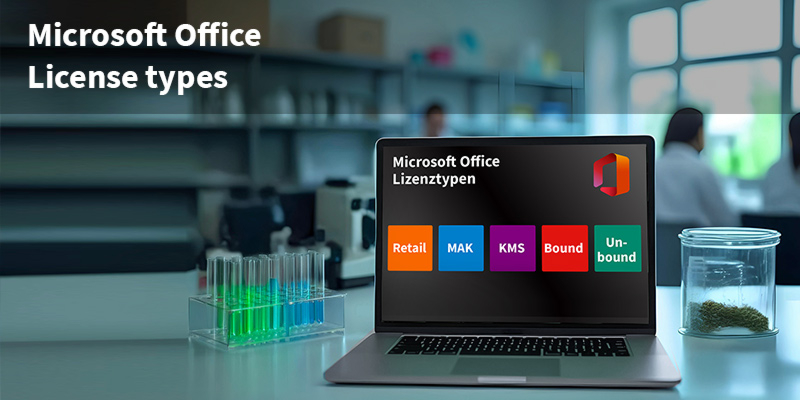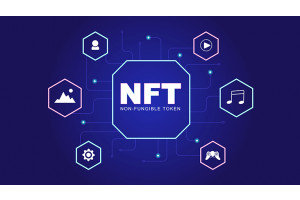This is a demo store. No orders will be fulfilled.
Microsoft Office license types explained: Differences between Retail, MAK, Bound, Unbound and Microsoft 365 - and which option is right for you


Microsoft Office license types at a glance
If you want to use Microsoft Office, you will quickly stumble across the different license types. Many users therefore ask themselves the following legitimate questions:
Which license best suits my requirements and budget?
The answer depends heavily on whether the software is to be used privately, for business or in a larger organization.
What are the differences between the Microsoft Office license types Retail, MAK, KMS, Bound/Unbound and Microsoft 365?
Microsoft's license models are diverse and sometimes difficult to distinguish. The terms retail license, MAK key, bound or unbound license key and Microsoft 365 subscription quickly cause confusion. At the same time, each variant offers clear advantages and possible restrictions - for example in terms of flexibility, costs or legal security.
Which activation is right for me?
Some editions are linked to a Microsoft account and allow reinstallation on new devices, while others are one-off activations that cannot be transferred.
How many devices and which programs are included in the different Microsoft Office license types?
The number of devices supported can range from a single computer to dozens of PCs with volume licenses, and the number of programs included also varies: some versions include Outlook, Publisher or Access, while others do not.
Should I choose a perpetual license or a subscription?
Basically, you can choose between a perpetual license and a Microsoft 365 subscription, which offers regular updates and additional cloud services.
Which option from the Microsoft Office license types is right for me?
To help you make the right decision, we explain all license types in detail in this article and in the table below. You will find out when a classic one-time purchase license is worthwhile, when a volume license model makes sense and in which cases Microsoft 365 is the better choice. In this way, you not only ensure legally compliant use, but also a long-term solution tailored to your way of working.
Read the structured overview of all major Office license types below and choose the version that meets your technical requirements, preferred functions and budget.
Comparison: Microsoft Office license types (without Microsoft 365)
| License type | License activation | Transferability | Target group / area of use |
|---|---|---|---|
| Retail | Product key; can often be linked to a Microsoft account | Yes, after uninstallating | Individual users, small businesses |
| MAK | One-time online/phone activation per device | Limited by activation quota | Organizations without their own activation network |
| KMS | Automatically via local KMS server (regular renewal) | Flexible within the network | Larger organizations with central license management |
| Bound / Unbound | Bound: bound to account - Unbound: unbound | Bound: transferable - Unbound: non-transferable | Bound for fixed bindings, unbound for flexible rights |
| License type | Versions | Included programs | Microsoft account | Activation type | Number of devices | One-time purchase | Special notes |
|---|---|---|---|---|---|---|---|
| Retail Unbound | Office 2019, 2021, 2024 Pro Plus / H&B / H&S | Pro Plus: Word, Excel, PowerPoint, Outlook, Publisher*, Access H&B: Word, Excel, PowerPoint, Outlook H&S: Word, Excel, PowerPoint |
No | One-time activation | 1 PC/Mac | *Publisher 2024 not included; generally not transferable | |
| Retail bound | Office 2019, 2021, 2024 H&S / H&B / Pro Plus | Like Unbound, depending on edition | Yes | Reinstallation possible after device change | 1 PC/Mac | License linked to Microsoft account | |
| MAK (volume license) | Office 2016-2024 Standard / Pro Plus | Like Standard or Pro Plus | No | Multiple activation (contingent) | 5-50 PCs | One key for multiple devices | |
| MacOS - Standard | Office 2016-2024 | Word, Excel, PowerPoint, Outlook | No | Serializer (one-time) | 1 Mac | No Publisher/Access | |
| MacOS - Home & Business | Office 2016-2024 | Word, Excel, PowerPoint, OneNote, Outlook | Yes | New installation possible | 1 Mac | Linked to account | |
| Microsoft 365 Single | Microsoft 365 | Word, Excel, PowerPoint, OneNote, Outlook | Yes | Subscription | 1 user (multiple devices) | Includes 1 TB OneDrive | |
| Microsoft 365 Family | Microsoft 365 | Word, Excel, PowerPoint, OneNote, Outlook | Yes | Subscription | Up to 6 users | Including 6 TB OneDrive total | |
| Microsoft 365 Business Basis | Microsoft 365 | Web/mobile apps; Teams, Exchange, OneDrive, SharePoint | Yes | Subscription | Per user | No desktop apps | |
| Microsoft 365 Business customers Standard | Microsoft 365 | Word, Excel, PowerPoint, Outlook, Publisher (PC), Access (PC) + Teams, Exchange, OneDrive, SharePoint |
Yes | Subscription | Per user | Publisher/Access on Windows PC only |
1. Retail licenses (one-time purchase licenses)
This option is particularly suitable for private users or small companies who want to purchase Microsoft Office once and use it indefinitely. Retail licenses are usually linked to a Microsoft account, which makes it much easier to reinstall them on a new device. Although they are often somewhat more expensive than other license types, they offer a high degree of flexibility and long-term legal security.
2. MAK licenses (Multiple Activation Key)
MAK keys are usually used as part of volume license agreements. They allow a certain number of activations, for example for companies with several workstations. As soon as the activation quota is exhausted, the key can no longer be used on additional devices. MAK licenses are a cost-effective solution for companies with clearly defined numbers of users, but are rather impractical for private users.
3. KMS licenses (Key Management Service)
KMS is another form of volume licensing that is mainly used in medium-sized and large companies. An internal KMS server is set up for this purpose, which regularly activates the Office installations in the network. The advantage: New devices can be activated quickly and easily without each workstation requiring an individual key. However, the activation must be renewed at regular intervals, which requires a permanent connection to the company network or VPN. This type of license is unsuitable for private users, but very efficient for organizations with many computers.
4. Bound keys (bound license keys)
With this type of license, the activation key is bound to the user’s Microsoft account (digital license), rather than permanently to a single device. This means that when Windows is reinstalled or installed on a new PC, signing in with the same account will automatically download and reactivate the license. Bound keys therefore allow easy reactivation and flexible hardware changes – provided this is done within the terms of the license and account.
5. Unbound keys (non-bound license keys)
With this type of license, the activation key is not linked to a Microsoft account, but used once during installation to activate Windows. If the key is later used on another device, the previous installation must be deactivated; otherwise the license will be reported as invalid. Transfers are possible but require manual action – both reinstallation and hardware changes mean the key has to be entered manually again.






